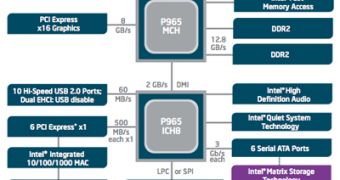There is finally good news for those unlucky computer users that decided to save a few dollars and make do with the integrated graphics solution from Intel's chipsets. Low end graphics as the integrated solutions are, the latest Intel products from this category proved to be even slower and poorer performing than the cheapest discrete video card on the market. And that after Intel said aloud for everyone to hear that the graphics integrated solution that can be found adorning the 965 chipset is ready and compatible with the latest DirectX specifications.
At the hardware level, the G965 integrated graphics chipset is quite advanced, featuring no less than eight programmable micro-execution engines that can take on even more complex calculations like pixel and vertex shading. As most newer games really need shading acceleration and because Intel's initial graphics drivers did not support hardware vertex shading, the whole workload related to shaders was thrown at the central processing unit. As the CPU is usually busy performing other sorts of task and because it does not have a specialized unit for shader processing, performance in the latest 3D games was sluggish at best.
While the new Intel released drivers will surely prove a step forward for users that choose to continue running the integrated graphics engine of the 965 chipset, the total performance will never be comparable to the level of discrete graphics solutions like those manufactured by Nvidia or AMD's ATI division.
According to an Intel blog, the company released the drivers for Microsoft's Windows XP and drivers for the Vista version of the operating system will soon follow. From the same site, we hear that users of the G965 graphics chipset can now envoy some of the more complex 3D games out there like Call of Duty 2, Far Cry and Battlefield 2. Overall, the new drivers should give a significant performance boost and the best news is that the driver will work with the mobile chipset and upcoming Intel G35 chipset.
One more piece of good news is that a new switching technology was implemented that allows users to select between hardware and software vertex shading. Depending on the application used, this could mean that users may send more computing power to a single application like a 3D game and let other application run with less.

 14 DAY TRIAL //
14 DAY TRIAL //